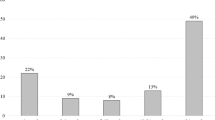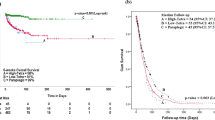Abstract
Study design:
Retrospective.
Objectives:
To determine the predictors of mortality in veterans with traumatic spinal cord injury (tSCI).
Setting:
Tertiary clinic in the state of Oklahoma.
Methods:
One hundred and forty-seven patients with tSCI who were enrolled in our Spinal Cord Injury program from 1 January 2000 to 31 December 2011 were retrospectively studied. The study sample was divided into two groups, based on the survival status by 31 December 2011.
Results:
In this sample of 147 patients with tSCI, survival at the end of the 12-year study period was 60%. There were three major causes of death: infection-related, such as pneumonia (21%), urinary infection (14%), and infection of the pressure ulcers (11%); cardiovascular-related, such as congestive heart failure (16%), coronary arterial disease (13%), and atrial fibrillation (2%); and cancer-related (16%). In veterans with complete SCI, deaths were mainly infection-related and occurred in the hospital (51%), while deaths in veterans with incomplete SCI were primarily cardiovascular and cancer-related and occurred in the community. A Cox regression analysis showed the age at the time of injury to be the main predictor of SCI-related mortality.
Conclusion:
This study suggests that an older age at the time of injury is a significant predictor of mortality following tSCI with patients more likely to die from cardiovascular deaths than the general population. These findings support the need for preventative strategies, including a focus on cardiovascular risk factor management, in order to decrease long-term mortality.
Similar content being viewed by others
Log in or create a free account to read this content
Gain free access to this article, as well as selected content from this journal and more on nature.com
or
References
National Spinal Cord Injury Statistical Center, Birmingham, Alabama https://www.nscisc.uab.edu. Accessed on 14 July 2012..
Strauss DJ, Devivo MJ, Paculdo DR, Shavelle RM . Trends in life expectancy after spinal cord injury. Arch Phys Med Rehabil 2006; 87: 1079–1085.
Lidal IB, Snekkevik H, Aamodt G, Hjeltnes N, Biering-Sørensen F, Stanghelle JK . Mortality after spinal cord injury in Norway. J Rehabil Med 2007; 39: 145–151.
O’Connor PJ . Survival after spinal cord injury in Australia. Arch Phys Med Rehabil 2005; 86: 37–47.
Whiteneck GG, Charlifue SW, Frankel HL, Fraser MH, Gardner BP, Gerhart KA et al. Mortality, morbidity, and psychosocial outcomes of persons spinal cord injured more than 20 years ago. Paraplegia 1992; 30: 617–630.
Samsa GP, Patrick CH, Feussner JR . Long-term survival of veterans with traumatic spinal cord injury. Arch Neurol 1993; 50: 909–914.
van den Berg ME, Castellote JM, de Pedro-Cuesta J, Mahillo-Fernandez I . Survival after spinal cord injury: a systematic review. J Neurotrauma 2010; 27: 1517–1528 Review.
Kaplan EL, Meier P . Nonparametric estimation from incomplete observations. J Am Statist Assn 1958; 53: 457–481.
Thietje R, Pouw MH, Schulz AP, Kienast B, Hirschfeld S . Mortality in patients with traumatic spinal cord injury: descriptive analysis of 62 deceased subjects. J Spinal Cord Med 2011; 34: 482–487.
Hall MK, Hackler RH, Zampieri TA, Zampieri JB . Renal calculi in spinal cord-injured patient: association with reflux, bladder stones, and foley catheter drainage. Urology 1989; 34: 126–128.
Rish BL, Dilustro JF, Salazar AM, Schwab KA, Brown HR . Spinal cord injury: a 25-year morbidity and mortality study. Mil Med 1997; 162: 141–148.
Bauman WA, Kahn NN, Grimm DR, Spungen AM . Risk factors for atherogenesis and cardiovascular autonomic function in persons with spinal cord injury. Spinal Cord 1999; 37: 601–616.
Furlan JC, Fehlings MG . The impact of age on mortality, impairment, and disability among adults with acute traumatic spinal cord injury. J Neurotrauma 2009; 26: 1707–1717.
Kattail D, Furlan JC, Fehlings MG . Epidemiology and clinical outcomes of acute spine trauma and spinal cord injury: experience from a specialized spine trauma center in Canada in comparison with a large national registry. J Trauma 2009; 67: 936–943.
Author information
Authors and Affiliations
Corresponding author
Ethics declarations
Competing interests
The authors declare no conflict of interest.
Rights and permissions
About this article
Cite this article
Rabadi, M., Mayanna, S. & Vincent, A. Predictors of mortality in veterans with traumatic spinal cord injury. Spinal Cord 51, 784–788 (2013). https://doi.org/10.1038/sc.2013.77
Received:
Revised:
Accepted:
Published:
Issue date:
DOI: https://doi.org/10.1038/sc.2013.77
Keywords
This article is cited by
-
In-hospital mortality rate in subaxial cervical spinal cord injury patients: a systematic review and meta-analysis
Acta Neurochirurgica (2023)
-
Primary Care in the Spinal Cord Injury Population: Things to Consider in the Ongoing Discussion
Current Physical Medicine and Rehabilitation Reports (2023)
-
International surveillance study in acute spinal cord injury confirms viability of multinational clinical trials
BMC Medicine (2022)
-
In-hospital mortality in people with complete acute traumatic spinal cord injury at a tertiary care center in India—a retrospective analysis
Spinal Cord (2022)
-
Respiratory complications during initial rehabilitation and survival following spinal cord injury in Sweden: a retrospective study
Spinal Cord (2021)



